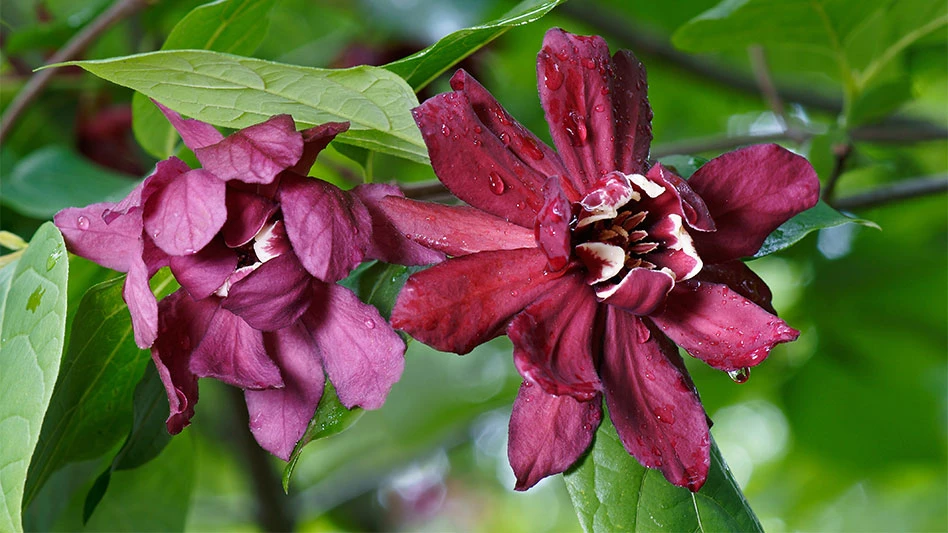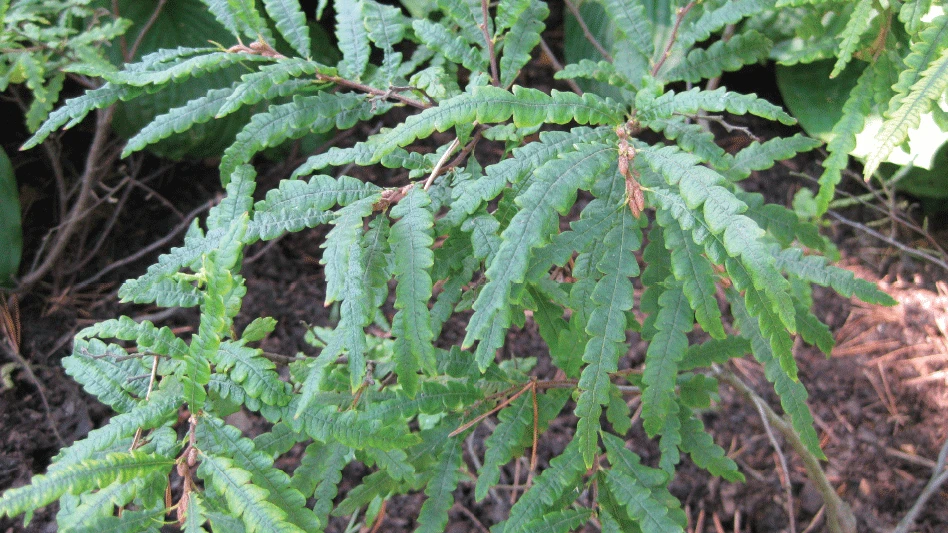 Paul CappielloThe plant material world has certainly come a long way since I took my first college woody plants course in 1979. Back then, ‘Bradford’ pear was on its way to becoming the savior of modern horticulture, and most were predicting that within 10 years, 90 percent of all nursery plants were going to be propagated by tissue culture. But are we really sure all our “progress” has actually been positive?
Paul CappielloThe plant material world has certainly come a long way since I took my first college woody plants course in 1979. Back then, ‘Bradford’ pear was on its way to becoming the savior of modern horticulture, and most were predicting that within 10 years, 90 percent of all nursery plants were going to be propagated by tissue culture. But are we really sure all our “progress” has actually been positive?
These days, it seems, every new plant has to be a veritable meadow muffin in a pot, growing no more than 3-feet by 3-feet with six months of fragrant flowers, fruit that lasts all winter and green leaves that look the same on Flag Day as they do on Groundhog Day. A garden populated with such dross seems dull as dishwater to me — why not just plant plastic?
Dull, predictable and unchanging would not be words to describe the several species of Exochorda. The pearlbushes, while not denizens of the limelight all year long, are among those plants that seem almost elemental to the transition from winter to spring. And there is something special and proper about those plants that mark the seasons — think magnolias, winterberry hollies and their ilk.
 Exochorda giraldii var. wilsonii features slightly larger flowers than E. racemosa.Show stopper
Exochorda giraldii var. wilsonii features slightly larger flowers than E. racemosa.Show stopper
Taxonomically, Exochorda species are all members of our old friend the Rosaceae. And while that designation does impart a five-parted reproductive morphology, the casual observer would not see much more that would scream “rose.” All Exochorda species are rather large and somewhat sprawling shrubs that grow 8-15 feet tall and a bit more around the waist. They are excellent specimens for the sunny or partly shaded border where they jump to the front in early spring, flower and then modestly retire to the background for cocktails once their flowers fade.
Flowers of all pearlbushes are pure white, 1- to 1∂-inch, five-petaled affairs typically borne in six- to 10-flowered racemes in early spring. They are completely devoid of fragrance and generally put on a show that lasts about two weeks. Fruit are five-parted, somewhat bizarre-looking pinwheels that start green and quickly turn brown.
The winter fruit is one of the few good winter ID features. A winter pearlbush without fruit will strike terror into the hearts of horticulture students. I remember fondly a specimen of E. racemosa that used to be (maybe still is) on the University of Illinois campus. The plant sat there all winter, stumping woody plant ID students and generally looking like a big smooth-barked honeysuckle. But in spring, when the flower buds began to swell, even engineering students, when appropriately prompted, would respond that the bush looked like it was covered with pearls. But once the flowers faded from view, the plant returned to its previous obscurity, providing shade for the bus stop bench.
 E. serratifolia is the most cold hardy of the species.Resilient choice
E. serratifolia is the most cold hardy of the species.Resilient choice
Pearlbushes are relatively easy to transplant and seem to have a fairly compact root system. And while the species are not ubiquitous in the nursery business, they can be found as both field and container grown offerings. All Exochorda species are easily multiplied by rooting summer stem cuttings. IBA levels from 1,000-7,000 parts per million have been reported as successful — honestly, when I’ve propagated pearlbush species in the past, I’ve usually just grabbed whatever powder or liquid I had laying around and can’t remember a poor success rate. I’ve had excellent results germinating seed following a 60- to 90-day cold stratification. While there is a long list of disease problems listed in many references, in my experience, plants tend to be almost completely free from serious problems.
Take your pick
Exochorda racemosa (common pearlbush) is the best known of this somewhat homogeneous group of Asian shrubs. It is a rather informal, rounded beast to about 15 feet. Simple ovate, 2- to 3-inch alternate leaves are a dull green with no notable fall color. Leaf margins can be sparsely serrate at the tip but may be entire on some plants/branches. This is an excellent plant for a brilliant splash of white in early spring. It’s hardy in USDA Hardiness Zones 4-8.
 E. racemosa (common pearlbush) grows up to 15 feet tall.E. giraldii var. wilsonii. Several references list the common name as redbud pearlbush and I suppose that isn’t all that misleading — except for the fact that it isn’t the flower buds as one might hope, but the emerging foliage that shows a suffusion of red color. Compared with E. racemosa, redbud pearlbush grows a bit larger and has slightly larger flowers. Straight E. giraldii can be found at the odd botanical garden, but it is the variety wilsonii that has begun to ooze ever so slowly into a few nursery catalogs. Redbud pearlbush is often listed as slightly less cold tolerant than E. racemosa, but I’ve not noticed much difference.
E. racemosa (common pearlbush) grows up to 15 feet tall.E. giraldii var. wilsonii. Several references list the common name as redbud pearlbush and I suppose that isn’t all that misleading — except for the fact that it isn’t the flower buds as one might hope, but the emerging foliage that shows a suffusion of red color. Compared with E. racemosa, redbud pearlbush grows a bit larger and has slightly larger flowers. Straight E. giraldii can be found at the odd botanical garden, but it is the variety wilsonii that has begun to ooze ever so slowly into a few nursery catalogs. Redbud pearlbush is often listed as slightly less cold tolerant than E. racemosa, but I’ve not noticed much difference.
E. racemosa may be a better selection for southern gardens. ‘Irish Pearl’ is listed several places as a vigorous growing hybrid of E. giraldii var. wilsonii and E. racemosa and described as having much longer than normal inflorescences. I’ve never seen the plant but it sounds like something worth trying.
E. korolkowii. Turkestan pearlbush looks pretty much like a pearlbush. In reviewing my notes from plants observed at the Arnold Arboretum, I couldn’t make much of a distinction between this and other species. I trundled across my office to pick up my copy of Dirr’s Manual of Woody Landscape Plants, turned to the Exochorda section, and was amazed to find Dirr’s same comment about the same plants at the Arnold.
E. xmicrantha ‘The Bride’ is a 3- to 4-foot mounded hybrid that makes an exquisite garden plant, producing somewhat small white flowers but producing them in great abundance. Cold hardiness is slightly less than E. serratifolia and E. racemosa, but plants work well in Zone 5. ‘The Bride’ and ‘Northern Pearls’ are the best of the bunch in my opinion. E. xmicrantha is a hybrid of E. racemosa and E. korolkowii.

Explore the October 2009 Issue
Check out more from this issue and find your next story to read.
Latest from Nursery Management
- How impending tariffs and USDA layoffs impact the horticulture industry
- Shifting the urban environment
- These companies are utilizing plastic alternatives to reduce horticultural waste
- How to create a sustainable plant nursery
- Lamiastrum galeobdolon ‘Herman’s Pride’
- One of rarest plants on earth: Tahina spectabilis
- Leading Women of Horticulture: Angela Labrum, Bailey Nurseries
- Get to know Pat Reilly with NewGen Boxwood and the American Boxwood Society





